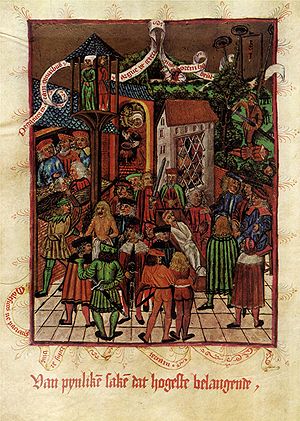Malleus Maleficarum
 | |
| Original Title: | Malleus Maleficarum |
|---|---|
| Written by: | Heinrich Kramer |
| Central Theme: | Sorcery is heresy |
| Synopsis: | Why witches should be killed |
| Genre(s): | Treatise |
| First published: | 1487 |
A witch-hunting manual written in 1486 by Heinrich Kramer, an Inquisitor of the Catholic Church, and first published in Germany in 1487. Jacob Sprenger's name is also attached to the book, though it is unclear if he did anything more than endorse it. The book, whose title translates to "Hammer of the Witches" is virulently misogynistic, though acknowledging that both men and women can be witches. The book proposed encouraged the use of torture in to extract confessions in ways that were not actually legal under the laws of the Inquisition. The book's original endorsement was probably forged; the Inquisition actually discouraged the use of this manual by their witch-hunters, but that did not prevent laymen from using it.
The chief crimes witches are accused of in the Malleus Maleficarum are the working of evil magic and making a Deal with the Devil in order to obtain this power. Women are, of course, more susceptible to The Devil due to their more carnal nature. Oddly enough, some of the most frequent crimes these sex-crazed sirens are accused of is stealing men's penises and causing impotency. Baby-killing and cannibalism were also apparently popular witch practices, often together.
Although some writers have claimed that the book was pretty much the cornerstone of a major anti-witchcraft movement and judges and priests all over Europe had a copy, and thus is associated with the image of the Inquisition being a torture-fest, History Marches On and it is not thought to be near as influential as once thought. Most theologians of Kramer's time condemned the book for recommending unethical and illegal procedures, and for being inconsistent with established Christian dogma on demonology, while the various Inquisitions had higher standards for evidence and ethics (the Inquisition established the modern Inquisitorial system used today) than the book proposed and witchcraft was never something they were especially interested in prosecuting, often maintaining a skepticism on whether witches even existed.
- All Women Are Lustful: The reason women are (allegedly) more susceptible to becoming witches.
- Author Tract: Kramer had a particular obsession with impotency curses.
- Burn the Witch: How to deal with your witch problem.
- Church Militant: Kramer
- The Dark Arts: As the power came from The Devil, all witchcraft was this.
- Deal with the Devil: How a witch gains power.
- Even Evil Has Standards: The Inquisition's standards for what was permissible when using torture were higher than Kramer's. They understood that torture could result in false confessions, so the length of time in which torture was permitted was limited, and confessions made under torture were not valid unless confirmed after the torture had ceased. If the confession was retracted, it was not permissible to recommence the torture; blam the heretic immediately.
- Eye of Newt: Witches used dead babies in their spells!
- Hot Witch: Evil young witches would try to seduce good Christian men.
- Magical Society: According to the manual, witches often gather to do evil deeds, and also go out and recruit new witches.
- Knight Templar: The witch-hunters
- Magic Is Evil
- Soulsaving Crusader: In the minds of Kramer and his devotees
- Well-Intentioned Extremist: Kramer again
- Wicked Witch: They are all wicked, according to Kramer.
- William Telling: Contains a story very similar to William Tell. Punker, Puncker, or Puncher of Rohrbach in the Upper Rhineland is said to have been ordered by "a very eminent person" in about 1430 to prove his extraordinary marksmanship (regarded by Kramer as a sign of consorting with the devil) by shooting a penny off the cap on his young son's head without disturbing the cap. Like William Tell, he too kept a second arrow in reserve to kill the prince in case he failed.
- Windmill Crusader: What most modern Westerners would call the witch-hunters.
- Widow Witch: Perhaps she fell into witchcraft because she lacked a husband's guidance, or perhaps she was the one who did him in.
- Witch Hunt: A handy how-to guide.
- The Witch Hunter